Bass fishing is more popular than playing golf or tennis. Consequently, there are more than 10 million bass anglers in the USA alone trying to find the right bait or lure to bring in the trophy bass of their dreams.
It is high time someone tackles the burning question: “What do bass eat?”
Unfortunately, the response is not simple. There are many different types of bass and they all feed pretty differently, as well. I will cover all these distinct bass species to answer the question properly.
Of course, the stress is on the largemouth bass since it is probably the most popular of all bass species. Yet, I won’t fail to mention smallmouth bass, white bass, spotted bass, striped bass, sea bass, and a few other rarer bass species, too.
I will also inform you how bass diet changes with age or season and list the best bass bait and lures. Knowing what bass love to eat and how, where, and when bass feed will help you catch these popular game fish. So, stay tuned!
What Do Different Bass Species Eat?
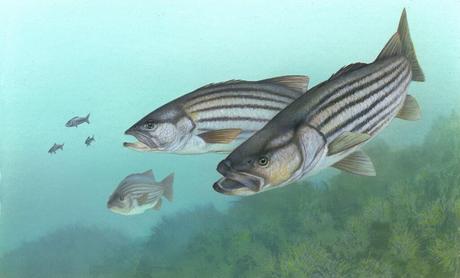
Largemouth Bass
Largemouth bass are opportunistic feeders that eat whatever fits their mouth. These shrewd hunters hunt throughout the water column. No insect, smaller fish, or crustacean is safe on either the bottom or surface of the water.
Most often, largemouth bass eat smaller fish such as minnows and shad. However, they can take on bigger fish such as trout, too. If they have a chance, they will swallow up a mouse, frog, and even small birds such as baby ducks.
Catching such unselective feeders seems easy, but it is not always the case. Hence, it would be wise to attempt to match the food largemouth bass eat in the habitat in which you are fishing. Try triggering their powerful sense of smell, too.
If you want to learn more about largemouth bass, watch the video below:
Smallmouth Bass
Young smallmouth bass eat plankton and insect larvae. As they grow older, baby bass grow more aggressive and start hunting for aquatic & terrestrial insects, crayfish, and smaller prey fish (sometimes even another smallmouth bass).
They might not be as big as largemouths, but smallmouth bass tend to put up quite a big fight. To catch smallmouth bass, cast a soft plastic lure or blade bait.
Striped Bass
Striped bass are saltwater fish that reside along the Atlantic coast of North America. At a young age, they mainly feed on larvae and little crustaceans. As adults, they eat whatever they can get a hold of, including anchovies, eels, squid, and even lobsters and crabs.
Spotted bass
Baby spotted bass consume plankton and insect larvae. Mature bass change their diet to crawfish, shad, and golden shiners. These predatory fish are highly adaptable, though, and can easily switch to any available food source. Try luring them with a night crawler – that usually does the trick!
White Bass
White bass are not as big as some other bass species. They are usually up to foot long, and thus their diet primarily consists of plankton, small insects, and smaller fish. You can use worms and minnows to lure them in.
Yellow Bass
Yellow bass is also on a smaller side. Yet, these fish are carnivores like their bigger cousins and thus enjoy eating insects, smaller fish, and small crustacean such as crayfish.
White Sea Bass
If you aim to catch bigger bass, consider white sea bass. These giant sea bass are larger than their freshwater relatives and can grow up to 3-feet long. They feed on anchovies, mackerel, herring, sardines, squid, and pelagic red crabs.
Due to their size, these huge bass fish do not have many natural enemies – only sharks, sea lions, and enthusiastic bass anglers.
Black Sea Bass
Black sea bass inhabit the coast from Maine to Texas. They are much smaller bass than white sea bass or largemouth bass.
Nevertheless, these small bass are opportunistic feeders just like their larger bass relatives- meaning they are willing to eat almost anything they can swallow, be it shrimp, clams, crabs, worms, or smaller fish.
Other Bass Species
There are a couple of bass species limited to a particular area. Yet, it does not mean they should be forsaken.
Alabama bass is so similar to spotted bass that the two are often mistaken. Their diet is pretty much the same, as well. Hence, Alabama bass typically eat crayfish and other smaller prey fish. They are quite gulpy and known to out-eat even largemouth bass.
Choctaw bass are often mistaken for largemouth or smallmouth bass. Their diet is based on smaller fish, such as minnows or crayfish.
Suwannee bass reside in rivers in Georgia and Florida. These small bass weigh under 4 lbs and eat small fish such as crayfish and crustaceans.
Guadalupe bass are tiny bass that live only in Texas. Their diet is based on insects.
Bartram’s bass are miniature fish that live in the Savannah River and feed on even smaller fish and insects. They are extremely rare and often illegal to fish.
Redeye bass are named by their distinctive red eyes. They are smaller bass species that mostly eat surface insects, smaller fish, and crustaceans.
Shoal bass are much like the redeye and smallmouth bass. They reside in shallow streams and enjoy eating crayfish.
How Do Bass Hunt?
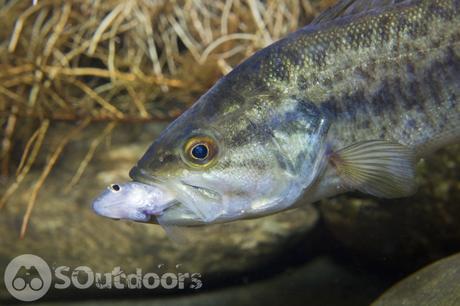
Studying bass feeding habits makes catching bass easier. So, please don’t skip this part! Most bass will eat anything they can fit into their mouth. Literally. Namely, bass hunt by sucking the prey in with their big mouth and chewing it up. They are unique in that regard – no other animal kills its prey in that manner.
When bass spot potential prey, they assume a position right in front of it and open their mouth. They then suck it in, chew, swallow, and digest it. Their digestive system is impressive, to say the least – it is known to dissolve things as solid as fishing hooks!
Bass hunt in three different ways:
- Ambushing their prey
Bass tend to hide in thick vegetation or around submerged structures such as rocks or logs. They wait for forage fish to swim by and then attack it by surprise.
- Patroling around underwater structures
Larger bass specimens often roam shallow water areas that hold some form of cover in search of their next meal. They suck in any food that comes their way.
- Chasing their prey
When a school of bass is close to a group of baitfish, the bass start to chase the forage and eat them on the go. Their tactic is to storm into their prey and strike it as hard as possible. As other prey fish disperse, bass swim back and eat the stunned baitfish.
If you wonder how bass suck in their prey, check out the following video:
How Does Bass Diet Change With Age?
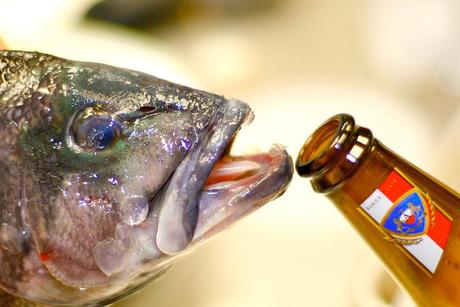
As I have already established, bass will eat almost anything that fits into their mouth. Hence, baby bass cannot have the same diet as adult bass. So, what do young bass eat?
Logically, baby bass eat smaller food than their fully-grown relatives. As they grow bigger, so does their potential prey.
When bass hatch, they swallow food they can find near the spawning area. The baby bass menu includes:
- Zooplankton
- Small insects
- Tadpoles
As they grow bigger, bass eat worms, leeches, and terrestrial insects. Once they become 6 inches long, bass start swallowing minnows, too.
What do adult bass eat?
As soon as bass grow at least 12 inches long, they start feeding on small fish such as shad, bluegill, shiners, perch, etc. They won’t mind eating a crayfish or two either.
When 4 to 5 lbs in size, bass start utilizing their very large mouth. It means their menu can finally include:
- Larger fish (such as adult bluegill & shad, or even young bass)
- Frogs
- Terrestrial critters
- Small snakes
How Do Seasonal Variations Affect Bass Diet?
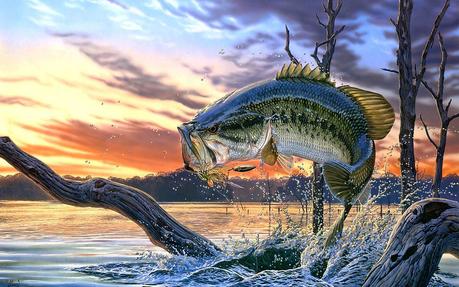
Seasonal changes affect bass feeding habits significantly. Bass will eat different food depending on the time of the year. It is mainly due to the changes in water temperatures, but bass mating habits play a major role too.
How Do Bass Fish Feed In Spring & Summer?
The bass spawning season begins in early spring (with the exception of northern waters). During a pre-spawn phase, bass start traveling towards the bedding areas and try to catch as many shad and crayfish along the way. The goal is to get enough nutrients to get through the fasting phase that follows soon after.
While guarding their nest, bass are not set on eating, but that does not mean they will not strike at anything that moves in their proximity. You can use this to your advantage and catch bass!
In the summer, once the spawning season is over, bass regain their appetite and start actively pursuing food such as shad, bluegills, and frogs. It is an ideal time for catching fish.
How Do Bass Fish Feed In Fall & Winter?
As temperatures drop during the early fall, bass, and most other fish species, start to eat like crazy. The goal is to prepare for the cold winter by becoming as big and fat as possible.
Bass begin roaming the shallow waters searching for crawfish, bluegills, insects, and frogs. Hence, fall bass fishing is an ideal opportunity to catch big largemouth bass and make a stuffed-bass feast for Thanksgiving.
Once the winter starts, bass typically move into deeper waters. They do not feed as actively, but won’t miss out on any feeding opportunity either. Their diet is primarily based on shad, but they will swallow anything that comes within their range.
Catching winter bass is not as easy as you would hope for. Just like most other fish, bass become lethargic and preserve their energy. They are not likely to chase after your bait.
If you insist on targeting bass during the cold season, choose the warmest part of the day. Bass become more active when water temperature increases, even slightly. You can find more winter fishing tips in the video below:
What Are The Best Bait & Lures For Bass Fishing?
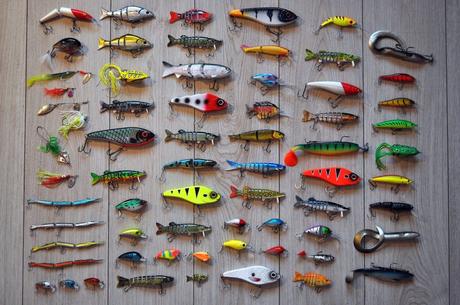
If you want to catch big bass, you must have the best bass fishing rod and the best bass bait & lures. These are live bait and lures, such as:
- Baitfish (shad, bluegill, etc.)
- Crawfish
- Frog lures
- Incest lures
- Mice
Artificial bait and lures that mimic the food bass eat in their natural habitat also work wonders. There are thousands of different options at your tackle store. It is best to attempt to match your lure to your fishing line and rod, fishing style/technique, and the environment you plan to fish in.
Also, refer to this article whenever you’re packing your tackle box. You’ll know exactly what bait to bring for targeting a largemouth bass or any other type of bass!
If you cannot decide between a spincast reel and a baitcast reel, follow this simple rule: use a baitcaster for heavy-duty bass fishing when targeting big bass in heavy cover or fast-moving waters, and opt for a spincast reel when you plan a more relaxed light-duty bass fishing.
The same goes for spinning reels. While baitcasters are reserved for heavy lures and fishing in heavy cover, spinning reels are used with lighter lures and finesse techniques.
For instance, if you bring a frog or a swimbait, pack a baitcasting reel. If, on the other hand, you opt for a micro jig or a drop shot rig, pack a spinning reel instead.
Extra Advice
Bass are actually pretty intelligent fish species. Therefore, if you prefer fishing at the same spot, you must change bass bait each day. If not, bass will learn how to avoid it, and you’ll be left empty-handed.
When Do Bass Eat?
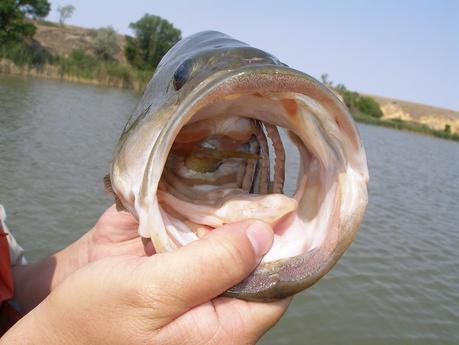
The final step in becoming a bass expert is learning when bass eat. The best time of the day to catch bass is at night.
These predatory fish feed more actively during nighttime since their big eyes can detect prey even when there is little light. Besides, you can enjoy less commotion and competition at your favorite fishing spot!
If you are not confident enough to fish at night, get out at dawn or dusk.
FAQs
What is bass favorite food?
Bass favorite food is the one that is the easiest to catch. They prefer feeding on forage fish, such as shad, golden shinners, or bluegill, but will enjoy eating anything that comes their way, including crayfish, shrimp, frogs, etc.
What do bass eat naturally?
Bass naturally eat whatever comes their way. They are easy-to-please, opportunistic feeders that eat insects, baitfish, crayfish, frogs, snakes, and even small birds and mice.
What is the best bait to catch bass?
The best bait to catch bass is live bait. Try to get a hold of some shad, minnows, or shiners, and your fishing trip will be a success. If you must use artificial bait and lures, mimic the food bass eat in the habitat you plan to fish in.
Will bass eat corn?
Bass will eat corn in the right circumstances, but it is by no means the go-to bait for catching bass fish. Corn kernels are much better spent on hatchery-raised trout and carp.
Are smallmouth bass bottom feeders?
Smallmouth bass are both bottom feeders and surface feeders, just like largemouth bass. Therefore, you can catch bass at the bottom, throughout the water column, and on the top of the water surface.
Final Observations
If you want to eat bass, you have to know what bass eat! It is as simple as that! Therefore, you’ll soon discover that catching bass is so much easier now that you know what they feed on!
Your fishing trips are about to become much more exciting! You’ll be bringing home the most popular game fish!
If you have any trouble or additional questions on how to catch largemouth bass or their close relatives, leave a comment, and I’ll get back to you.

